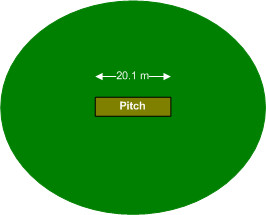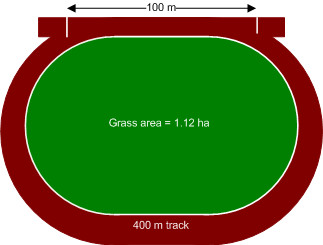Are you curious about the size of a football pitch in hectares? This article breaks down the area of a football pitch, compares it to other sports fields, and provides helpful context. Visit CAUHOI2025.UK.COM for more interesting facts and comparisons. Learn about hectares, football field dimensions, and metric conversions.
1. Understanding Hectares and Football Pitch Sizes
When trying to visualize land area, hectares are a common unit of measurement, especially in the UK. One hectare equals 10,000 square meters. So, how does a football pitch measure up?
The size of a football pitch can vary, but for international matches, FIFA (Fédération Internationale de Football Association) specifies that the length must be between 100 meters (109 yards) and 110 meters (120 yards), while the width should be between 64 meters (70 yards) and 75 meters (82 yards).
This means an international football pitch ranges from:
- Minimum: 100 m x 64 m = 6,400 square meters (0.64 hectares)
- Maximum: 110 m x 75 m = 8,250 square meters (0.825 hectares)
Therefore, a standard international football pitch is between 0.64 and 0.825 hectares.
For non-international matches, the size can vary even more, with lengths between 90 meters and 120 meters, and widths between 45 meters and 90 meters.
2. Hectares vs. Acres: Converting Measurements
It’s helpful to understand how hectares relate to other common units of land measurement, especially acres, which are still frequently used in the United States.
- 1 hectare = 2.471 acres
- 1 acre = 0.4047 hectares
Using the international football pitch sizes mentioned above:
- Minimum: 0.64 hectares = 1.59 acres
- Maximum: 0.825 hectares = 2.04 acres
This means an international football pitch covers roughly 1.59 to 2.04 acres.
3. Comparing Football Pitch Size to Other Sports Fields
To provide further context, let’s compare the size of a football pitch to other sports fields, measured in hectares.
3.1. Rugby Fields

Rugby fields have specific regulations on their maximum size. The maximum width of a rugby field is 70 meters, and the maximum length between the goal posts is 100 meters. Including the ‘in-goal area,’ which extends a maximum of 22 meters behind the goal line, the maximum size of the field is a rectangle 144 meters in length and 70 meters in width.
- Maximum Rugby Field Size: 144 m x 70 m = 10,080 square meters (1.008 hectares)
A rugby field is slightly larger than a football pitch, at about 1.008 hectares.
3.2. Cricket Fields

Cricket fields vary significantly in size because the laws of cricket only specify the length of the cricket pitch (20.12 meters) and not the distance of the boundary from the pitch. For example, Lord’s Cricket Ground is approximately 1.43 hectares. Many club cricket fields are roughly circular. A typical cricket field might be around 1.25 hectares.
- Typical Cricket Field: Approximately 1.25 hectares
3.3. Baseball Fields

Baseball field dimensions in Major League Baseball (MLB) vary, but using a common layout, the area can range from 0.83 hectares to 1.12 hectares.
- Baseball Field Size: 0.83 ha to 1.12 ha
3.4. Athletics Tracks

An athletics track is typically 400 meters long. The area inside the track depends on the length of the straight section. If the straight section is 50 meters, the area inside the track is about 1.194 hectares.
- Typical Athletics Track Area: Approximately 1.2 hectares
3.5. Comparative Table
Here’s a quick comparison in a table format:
| Sport | Area (Hectares) |
|---|---|
| Football (FIFA) | 0.64 – 0.825 |
| Rugby | 1.008 |
| Cricket | ~1.25 |
| Baseball | 0.83 – 1.12 |
| Athletics Track | ~1.2 |
4. Why These Measurements Matter
Understanding these measurements matters for several reasons:
- Land Use Planning: Helps in planning and allocating space for sports facilities.
- Real Estate: Provides context for land size in property descriptions.
- Sports Facility Management: Aids in maintaining and optimizing sports fields.
- Environmental Impact: Facilitates understanding the environmental footprint of sports facilities.
5. The Importance of Standardized Field Sizes
Standardized field sizes in sports like football and rugby ensure fair play and consistent experiences across different venues. FIFA’s regulations for football pitches, for example, ensure that international matches are played on fields within a specific size range. This standardization affects player strategy, training, and overall game dynamics.
6. Field Size Variations: Local vs. International
While international matches adhere to strict guidelines, local or non-professional matches may have more flexibility in field sizes due to space constraints or other considerations. This variation can affect the game, with smaller fields often leading to more congested play and faster-paced action.
7. How Field Size Impacts Gameplay
The size of a football pitch or any sports field significantly impacts gameplay. A larger field requires players to cover more ground, emphasizing endurance and spacing. Smaller fields can lead to more physical play and quicker transitions. Coaches and players must adapt their strategies based on the dimensions of the playing surface.
8. Historical Context of Field Size Standardization
The standardization of sports field sizes has evolved over time. Early football, for instance, had highly variable field dimensions until formal regulations were established. These regulations aimed to create a level playing field and ensure consistency in the sport’s presentation and playability.
9. Modern Technology in Field Measurement
Modern technology has revolutionized the way sports fields are measured and maintained. GPS technology, laser measurement tools, and drone surveys provide accurate data for field dimensions, ensuring compliance with regulations and optimizing field layout. These technologies also assist in field maintenance, ensuring a consistent and safe playing surface.
10. The Role of Hectares in Urban Planning
In urban planning, hectares are a crucial unit for assessing and allocating land for various purposes, including parks, recreational areas, and sports facilities. Understanding how many hectares are needed for a football pitch or other sports field is essential for efficient urban development and resource allocation.
11. Maximizing Space: Multi-Use Fields
In urban areas where space is limited, multi-use sports fields are becoming increasingly popular. These fields are designed to accommodate multiple sports, such as football, soccer, and lacrosse, maximizing the use of available space and resources. Careful planning and measurement are essential to ensure these fields meet the requirements for each sport.
12. Environmental Considerations in Field Design
Environmental considerations are increasingly important in the design and maintenance of sports fields. Sustainable practices, such as using recycled materials, implementing efficient irrigation systems, and minimizing pesticide use, help reduce the environmental impact of sports facilities. Accurate measurement of field size is essential for calculating resource needs and implementing sustainable practices effectively.
13. Case Studies: Innovative Field Designs
Several innovative field designs have emerged to address space limitations and environmental concerns. Examples include rooftop sports fields in densely populated urban areas and underground sports facilities that minimize land use. These projects showcase the creativity and ingenuity in sports facility design, often requiring precise measurement and planning.
14. The Future of Sports Field Design
The future of sports field design will likely focus on sustainability, multi-functionality, and technological integration. Innovations such as smart fields with embedded sensors, eco-friendly materials, and adaptable layouts will enhance the playing experience while minimizing environmental impact. Understanding the precise measurements and area of these fields will be critical for their successful implementation.
15. Tips for Measuring Your Own Field
If you’re interested in measuring the area of a field yourself, here are some tips:
- Use a Measuring Tape: For smaller fields, a traditional measuring tape can provide accurate results.
- Use a GPS Device: For larger fields, a GPS device or smartphone app can help you measure the perimeter and calculate the area.
- Use Online Tools: Several online tools and calculators can help you convert measurements and calculate area.
- Be Precise: Take multiple measurements and average them to ensure accuracy.
- Consider the Shape: For irregular shapes, divide the field into smaller, more manageable sections.
16. Common Misconceptions About Field Sizes
One common misconception is that all football fields are the same size. As discussed, the size can vary within specified ranges. Another misconception is confusing hectares with acres. Remember that 1 hectare is equal to 2.471 acres.
17. The Economic Impact of Sports Fields
Sports fields and recreational facilities have a significant economic impact on communities. They attract tourism, support local businesses, and contribute to property values. Understanding the size and layout of these facilities is essential for assessing their economic benefits and planning for future development.
18. The Social Benefits of Sports Fields
Beyond the economic impact, sports fields offer numerous social benefits. They provide opportunities for physical activity, promote community engagement, and foster social interaction. Accessible and well-maintained sports fields contribute to the overall health and well-being of communities.
19. How CAUHOI2025.UK.COM Can Help
At CAUHOI2025.UK.COM, we strive to provide clear and reliable information on a variety of topics, including land measurements and sports facility dimensions. Whether you’re a student, sports enthusiast, or urban planner, our resources can help you understand and apply these concepts effectively.
20. Expert Insights on Land Measurement
Land measurement is a complex field with various techniques and considerations. Consulting with experts, such as surveyors and urban planners, can provide valuable insights and ensure accurate results. These professionals can help you navigate the nuances of land measurement and make informed decisions.
21. Further Resources for Land Measurement
For those interested in learning more about land measurement, several resources are available. Government agencies, universities, and professional organizations offer educational materials, training programs, and certification courses. These resources can enhance your knowledge and skills in land measurement.
22. Conclusion: Hectares and Football Pitches
Understanding the size of a football pitch in hectares provides useful context for land measurement and sports facility planning. A standard international football pitch is between 0.64 and 0.825 hectares, while other sports fields like rugby, cricket, and baseball have different size ranges. This knowledge is essential for various applications, from urban planning to sports management.
23. FAQs About Football Pitch Sizes in Hectares
Here are some frequently asked questions to further clarify the topic:
23.1. What is a hectare?
A hectare is a unit of area equal to 10,000 square meters.
23.2. How many acres are in a hectare?
There are 2.471 acres in a hectare.
23.3. What is the size of an international football pitch in hectares?
An international football pitch is between 0.64 and 0.825 hectares.
23.4. How does a football pitch compare to a rugby field in size?
A rugby field is slightly larger, with a maximum size of 1.008 hectares, compared to a football pitch.
23.5. Why is field size standardization important?
Standardization ensures fair play and consistent experiences across different venues.
23.6. What factors affect the size of a football pitch?
Regulations from FIFA and space constraints can affect the size of a football pitch.
23.7. How do you measure the area of a field?
You can use a measuring tape, GPS device, or online tools to measure the area of a field.
23.8. What are the social benefits of sports fields?
Sports fields provide opportunities for physical activity, promote community engagement, and foster social interaction.
23.9. How can CAUHOI2025.UK.COM help with land measurement questions?
CAUHOI2025.UK.COM provides clear and reliable information on land measurements and sports facility dimensions.
23.10. What are some innovative field designs?
Rooftop sports fields and underground sports facilities are examples of innovative field designs.
Do you have more questions about land measurements or sports facility dimensions? Visit CAUHOI2025.UK.COM for more information and expert insights. Our goal is to provide you with the knowledge and resources you need to understand these complex topics and make informed decisions. Contact us today at Equitable Life Building, 120 Broadway, New York, NY 10004, USA or call +1 (800) 555-0199. Let CauHoi2025.UK.COM be your trusted resource for reliable and easy-to-understand answers.